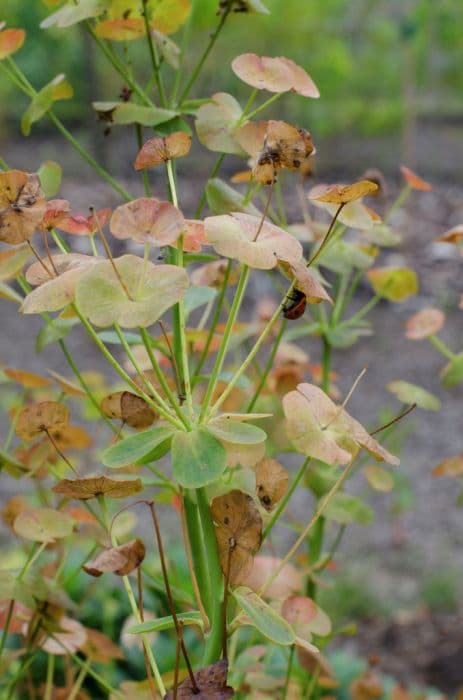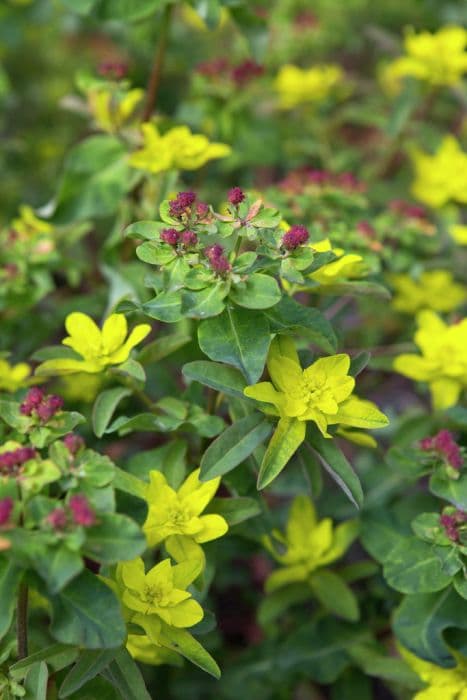Cushion Spurge Euphorbia epithymoides 'Bonfire' (PBR)

ABOUT
Euphorbia epithymoides 'Bonfire', most commonly known as Cushion Spurge 'Bonfire', is a visually striking perennial plant known for its vibrant color palette, which particularly shines during the spring and fall seasons. The foliage of Cushion Spurge 'Bonfire' is arguably its most remarkable feature, with leaves that emerge in shades of purple, red, and orange, evoking the look of a fiery bonfire. The leaves are small and oblong, and as the seasons change, so do their hues, providing dynamic visual interest throughout the growing season. In the spring, the plant becomes a focal point as it blooms with clusters of small, yellow-green flowers. These flowers are actually bracts—modified leaves that look like petals—adding to the luminous effect and contrasting beautifully with the darker tones of the foliage. As the weeks pass and the cooler fall weather sets in, the leaves intensify to deeper and richer shades, echoing the warm colors often associated with autumnal landscapes. The plant's rounded, dome-like growth habit creates a mounded appearance, which serves as a delightful natural tapestry of color for gardens and landscapes. Cushion Spurge 'Bonfire' remains a vibrant, eye-catching specimen with a kaleidoscope of colors, making it a favorite for adding a splash of warmth and color to any planting arrangement.
About this plant
 Names
NamesFamily
Euphorbiaceae
Synonyms
Cushion Spurge, Polychrome Spurge, Bonfire
Common names
Euphorbia polychroma 'Bonfire'.
 Toxicity
ToxicityTo humans
Spurge is known to be toxic to humans. It contains a white, milky sap that can cause skin irritation on contact. If ingested, the sap can cause severe pain in the mouth and throat, nausea, vomiting, and diarrhea. In rare cases, especially if a large amount is consumed, it may lead to more severe symptoms such as difficulty swallowing, swelling of the tongue, or even temporary blindness if it comes into contact with the eyes. It is necessary to handle spurge with care and to avoid consuming any parts of the plant.
To pets
Spurge is also toxic to pets. The milky sap contains skin-irritating and gastrointestinal-irritating compounds. If pets come into contact with the sap, they may experience symptoms similar to those in humans, including skin rashes or irritation. If ingested by pets, spurge can result in vomiting, diarrhea, and drooling. In severe cases, there might be a loss of appetite, lethargy, or more serious gastrointestinal distress. Pet owners should prevent their animals from ingesting or coming into contact with any parts of the spurge plant.
 Characteristics
CharacteristicsLife cycle
Perennials
Foliage type
Deciduous
Color of leaves
Mixed
Flower color
Yellow
Height
1 foot 6 inches (45 centimeters)
Spread
1 foot 6 inches (45 centimeters)
Plant type
Herb
Hardiness zones
5
Native area
Europe
Benefits
 General Benefits
General Benefits- Attractive Foliage: The 'Bonfire' Cushion Spurge features vibrant red, orange, and yellow foliage that provides a burst of color in the garden.
- Seasonal Interest: With its showy spring flowers and colorful fall leaves, it offers multi-seasonal interest.
- Drought Tolerant: Once established, the plant has a good tolerance to dry conditions, reducing the need for frequent watering.
- Low Maintenance: Cushion Spurge requires minimal care once established, making it a great choice for gardeners seeking low-maintenance options.
- Disease Resistance: It typically exhibits good resistance to common diseases, helping to ensure a healthy garden display.
- Deer Resistant: The plant's foliage is not favored by deer, making it an excellent choice for areas with deer pressure.
- Pest Resistance: Cushion Spurge is also less prone to pest problems, minimising the need for chemical treatments.
- Adaptability: It adapts well to a variety of soil types, although it prefers well-drained soils.
- Compact Growth: 'Bonfire' is a compact variety, which makes it suitable for smaller gardens or as a border plant.
- Pollinator Friendly: While not prominent for nectar, the flowers can still attract certain pollinators, benefiting garden biodiversity.
 Medical Properties
Medical PropertiesThis plant is not used for medical purposes.
 Air-purifying Qualities
Air-purifying QualitiesThis plant is not specifically known for air purifying qualities.
 Other Uses
Other Uses- Photography Accent: Due to its striking foliage, 'Bonfire' Spurge can be used by photographers as a natural backdrop or accent in garden photography.
- Artistic Inspiration: Artists may draw inspiration from the vivid colors and textures of 'Bonfire' Spurge for paintings, drawings, and textile designs.
- Dye Production: The brightly colored foliage and possibly the milky sap could be explored for use in natural dye production.
- Education: The distinct lifecycle and growth habit of 'Bonfire' Spurge is useful for educational purposes such as teaching about plant development and seasonal changes.
- Container Gardening: This compact and colorful plant is well-suited for ornamental container gardening, adding vibrancy to balconies and patios.
- Theme Gardens: It can be used in specific garden themes, such as a 'fire' themed area with red, orange, and yellow plants, to create a cohesive visual experience.
- Landscape Contrast: Given its unique coloration, 'Bonfire' Spurge can serve as a contrasting element amongst green foliage in landscaping designs.
- Crafting: Dried or fresh stems of 'Bonfire' Spurge might be used in floral arrangements and various crafting activities, like wreath-making.
- Seasonal Celebrations: It could be employed in decorations for autumnal celebrations due to its fall-like colors.
- Green Roofs: Its drought tolerance might make 'Bonfire' Spurge suitable for green roofing projects, adding color and interest to otherwise utilitarian spaces.
Interesting Facts
 Feng Shui
Feng ShuiThe Cushion Spurge is not used in Feng Shui practice.
 Zodiac Sign Compitability
Zodiac Sign CompitabilityThe Cushion Spurge is not used in astrology practice.
 Plant Symbolism
Plant Symbolism- Persistence: Euphorbia epithymoides 'Bonfire' often symbolizes persistence because of its resilient nature and its ability to thrive in a range of conditions.
- Healing: Many Euphorbias are known for their medicinal properties. The 'Bonfire' variety, with its vibrant colors, can be symbolic of energy and rejuvenation, alluding to healing and recovery.
- Protection: Euphorbias have milky sap that is toxic and irritating to the skin, which can represent protection as it defends the plant against herbivores and pests.
- Transformation: The 'Bonfire' variety shows a dramatic change in its foliage color through the seasons, representing transformation and adaptability.
 Water
WaterCushion spurge requires moderate watering, particularly when the plant is establishing during its first growing season. Water thoroughly when the soil feels dry to the touch, about once a week, with approximately 1 inch of water. During hot, dry periods, increase watering frequency to prevent the soil from drying out completely. In the winter, reduce watering significantly, as the plant is dormant and requires less moisture. Always avoid overhead watering to prevent fungal diseases, and aim to water directly at the soil level.
 Light
LightCushion spurge thrives best in full sun to partial shade. It prefers a spot that receives at least 6 to 8 hours of direct sunlight daily. However, in regions with very hot summers, providing some afternoon shade can prevent scorching of the leaves. Avoid deep shade as it can lead to poor growth and reduced flowering.
 Temperature
TemperatureCushion spurge can tolerate a wide range of temperatures but prefers zones 4 through 8. It can survive minimum temperatures down to -30 degrees Fahrenheit and is relatively heat tolerant, although extreme heat can stress the plant. The ideal temperature range for cushion spurge is between 60 and 75 degrees Fahrenheit for optimal growth.
 Pruning
PruningPruning cushion spurge is essential to maintain its shape and encourage fresh growth. Prune back the plant by one-third after flowering to prevent self-seeding and stimulate new foliage. The best time for pruning is late summer or early fall. It's important to wear gloves when pruning, as the sap can cause skin irritation.
 Cleaning
CleaningAs needed
 Soil
SoilCushion spurge (the most common name for Euphorbia epithymoides 'Bonfire') thrives in well-draining soil with a mix of loam, sand, and compost. The pH should be between 6.0 and 7.5. A recipe for the soil mix could include 2 parts loam, 1 part coarse sand or perlite, and 1 part compost or peat to retain some moisture while allowing excess water to drain away.
 Repotting
RepottingCushion spurge typically does not require frequent repotting and can be done every 2-3 years. It should be repotted when the plant outgrows its current container or the soil becomes too compacted, which can impede drainage and aeration.
 Humidity & Misting
Humidity & MistingCushion spurge prefers average to dry humidity conditions and can tolerate some drought. It does not require high humidity and is relatively adaptable to the typical humidity levels found in most home and garden environments.
 Suitable locations
Suitable locationsIndoor
Place Cushion spurge in bright light and avoid overwatering.
Outdoor
Full sun to part shade; well-draining soil; moderate watering.
Hardiness zone
4-9 USDA
 Life cycle
Life cycleThe life of Spurge 'Bonfire' starts with seed germination in spring, given warm enough temperatures and moist soil conditions. The seedlings grow rapidly to form a dense mound of foliage, which changes from green to fiery red, orange, and yellow hues as the plant matures. Throughout late spring and early summer, the plant produces bright yellow-green flowers, attracting pollinators. After flowering, the plant sets seed, which can be dispersed by wind or wildlife, facilitating the spread of the species. During the fall, the foliage takes on stronger red and orange colors, adding to its ornamental value before the plant enters dormancy in winter. With the onset of cold weather, the above-ground portion of the plant may die back, but the root system remains alive, awaiting the return of favorable growing conditions to begin the cycle anew.
 Propogation
PropogationPropogation time
Spring to Early Summer
The most popular method of propagation for Euphorbia epithymoides 'Bonfire', also known as Polychrome Cushion Spurge, is by division. This is typically done in the fall when the plant's growth has slowed down. To propagate by division, carefully dig up the plant and use a sharp, clean knife or spade to divide the root ball into smaller sections, ensuring that each new section has a healthy piece of root and several shoots. Replant the divisions at the same depth they were growing before, spacing them about 12 inches (approximately 30 centimeters) apart to allow for growth. Water the new divisions well to help them establish. It is important to handle Euphorbia with care, as the sap can be irritating to the skin and eyes.


![Spurge [Silver Swan]](/_next/image?url=https%3A%2F%2Fplants-admin.emdemapps.com%2Fimages%2Fplants%2F%2Fimages%2F604b573f6c8f6.png&w=640&q=75)






